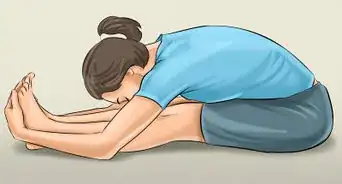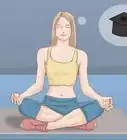wikiHow is a “wiki,” similar to Wikipedia, which means that many of our articles are co-written by multiple authors. To create this article, volunteer authors worked to edit and improve it over time.
There are 7 references cited in this article, which can be found at the bottom of the page.
wikiHow marks an article as reader-approved once it receives enough positive feedback. In this case, 92% of readers who voted found the article helpful, earning it our reader-approved status.
This article has been viewed 201,799 times.
Learn more...
These instructions are for individuals who have practiced yoga before and are interested in learning how to perform a headstand properly in order to enhance cardiovascular venous return. These instructions are a courtesy to Yoga Mind and Body produced by the Sivananda Yoga Vedanta Center.
Those who are pregnant, or suffer from chronic cardiac or musculoskeletal issues should consult a doctor before attempting a headstand. Even after consulting a doctor, those with health problems may still need a professional yoga instructor as a guide for this pose. Beginners may choose to use a wall as a prop when performing the headstand to facilitate the pose until enough balance has been acquired to stand alone.[1] Beginners may also want to practice in pairs until acquiring enough confidence to perform the pose solo.
Steps
-
1Begin the position in child’s pose.[2]
- Lower down on to your knees on the mat. Sit back onto your feet.
- Lean forward until your forehead is resting comfortably on the ground. Your chest should be resting on your thighs. Allow arms to lie limp at your sides with palms facing up.
-
2Relax in child’s pose. Monitor your breathing and focus on silence for 30 seconds.Advertisement
-
3Lift only your head while moving your elbows onto the ground in front of your knees.
-
4Wrap a hand around each elbow without lifting your elbows off the floor.
-
5Plant your elbows in this position. Never change this distance between your elbows throughout the duration of the headstand.[3]
-
6Release the hold on your elbows and pivot your forearms forward so they are parallel to one another.[4]
-
7Bring your hands together and interlock the fingers. Your elbows and hands should form a triangle.[5]
-
8Lift your hips up and forward so your head lands into the palm of your hands. Knees stay on the ground.
-
9Adjust your head so the top of your cranium is directly on the ground and your hands are resting in the back of your head. Do not move your elbows.
-
10Plant the balls of your feet into the ground and push so your knees extend up away from the ground and your body is lifted into the air. (Your body should form an upside down V).[6]
-
11Slowly walk your feet towards your face. As you walk, your spine will straighten out above your head and you will notice your weight slowly shift from your feet to your elbows. When you can’t walk further, push your elbows into the ground.
-
12Lift your feet into the air naturally as all of your weight shifts onto your elbows.
-
13Continue lifting up your thighs until they are directly above your abdomen. Your elbows should hold a majority of the weight of your body, not your head or neck.[7]
-
14Keep knees bent for now. Tighten abdomen. Remain in this position for 30 seconds. Focus on your balance. When fully balanced, slowly extend lower legs up above the waist.
-
15Point your toes. Stay in this position for no more than 3 minutes.[8]
Things You'll Need
- Yoga mat
- Comfortable, flexible clothes (yoga pants, and tank top preferable)
- Large quiet space
- Wall (optional)
References
- ↑ https://www.doyouyoga.com/a-beginners-guide-to-headstands-14010/
- ↑ https://www.youtube.com/watch?v=eqVMAPM00DM
- ↑ https://www.youtube.com/watch?v=ITBdNnZ8k2I
- ↑ https://www.youtube.com/watch?v=ITBdNnZ8k2I
- ↑ https://www.youtube.com/watch?time_continue=12&v=lOUpNVFIFWE
- ↑ https://www.shape.com/fitness/workouts/step-step-breakdown-headstand?slide=4ed3482b-a40f-44bf-b1ff-7b0233f92472#4ed3482b-a40f-44bf-b1ff-7b0233f92472
- ↑ https://www.shape.com/fitness/workouts/step-step-breakdown-headstand?slide=9023759d-d478-4c31-a610-96b00e1b97b1#9023759d-d478-4c31-a610-96b00e1b97b1
- ↑ https://www.shape.com/fitness/workouts/step-step-breakdown-headstand?slide=f77a97cf-12ad-446c-b698-31043cc9dd90#f77a97cf-12ad-446c-b698-31043cc9dd90
-Step-1-Version-6.webp)
-Step-2-Version-6.webp)
-Step-3-Version-6.webp)
-Step-4-Version-6.webp)
-Step-5-Version-6.webp)
-Step-6-Version-6.webp)
-Step-7-Version-6.webp)
-Step-8-Version-6.webp)
-Step-9-Version-6.webp)
-Step-10-Version-6.webp)
-Step-11-Version-6.webp)
-Step-12-Version-6.webp)
-Step-13-Version-6.webp)
-Step-14-Version-6.webp)
-Step-15-Version-6.webp)









-Step-16.webp)


















































